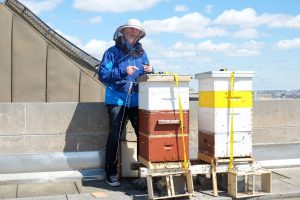The Brooklyn Museum maintains two rooftop beehives, and several more New York museums are joining the apiculture craze

Bruce Gifford of Cultured Bees tending to the beehives on the roof of the Brooklyn MuseumCourtesy Brooklyn Museum
Brooklyn is buzzing. Sitting on top of the Brooklyn Museum are two beehives, each housing between 10,000 and 50,000 honey bees that travel an average of three miles in search of nectar, pollinating local flowers in the process.
The beehives are part of the museum’s sustainability initiatives, which also include an internal Sustainability Task Force, as well as programs, events and exhibitions related to environmental justice and climate change. Installed and maintained by beekeeper Bruce Gifford of Cultured Bees, the hives are part of a growing movement to use cultural spaces to support local ecosystems.
The Brooklyn Museum began its green initiatives in 2022 to promote socially and environmentally conscious change within the institution and community. “We developed a ‘social action framework’,” says Adjoa Jones de Almeida, the museum’s deputy director for learning and social impact. “This framework proposes a sustained, multi-year commitment to two key issues reflecting broad and urgent global themes with serious repercussions for Brooklyn and our world: climate change and mass criminalisation.”
To address these issues, the museum has been taking small steps, such as phasing out single-use plastic bottles, along with making larger structural changes, including updating gas and electric equipment to reduce operational carbon emissions. The museum is also supporting the work of local social and climate justice organizations and sustainability initiatives through partnerships and community engagement.
Emblematic of this local outreach are the thousands of bees that descend from the museum’s roof and pollinate the surroundings, including the adjacent Prospect Park and the Brooklyn Botanic Garden. An individual bee pollinates around 1,000 flowers per day, so each colony may be pollinating 50 million flowers daily. While bees are self-sufficient, Gifford assists the initial growth, feeding new hives sugar water at least once a week until they support themselves by foraging for nectar. He monitors the bees throughout the spring and summer, visiting every few weeks to check overall health and add layers if needed. He harvests surplus honey in the fall and leaves enough for the bees to survive the winter.
“Providing bees a safe space to build their colonies while learning about their society and social structure is fascinating,” says Gifford. “I love observing the structure of a hive–their democratic decision making–and the crucial role bees play in our ecosystem. All are opportunities to spark productive conversations and provide a lens to ponder human societies.”
Beekeeping was legalized in New York City in 2010 when the municipal board of health voted unanimously to lift one of the only bans on the practice in the United States. The first museum beehives in the city were installed shortly thereafter at the Whitney Museum of American Art in its former Upper East Side location. Moving downtown along with the museum in 2015, the bees now pollinate the High Line and are maintained by beekeepers Chucker Branch and Christine Lehner.
In addition to the Brooklyn Museum’s beehives, Gifford installed and maintains two rooftop hives at the Museum of Arts and Design (Mad). Constructed last spring, the hives pollinate Central Park and are also home to up to 50,000 bees each, including two queens: Queen Aileen, named after Mad’s founder, Aileen Osborn Webb, and Queen Toshiko Takaezu, named for the famed ceramic artist and museum supporter.
This spring, the Museum of Modern Art (Moma) is working with Gifford to install four beehives of its own. Additionally, for the first time since 2015, Moma will exhibit its renowned Pierre Huyghe sculpture Untilled (Liegender Frauenakt) (2012) beginning in June as part of a contemporary art installation in its sculpture garden. The work features a concrete nude female figure whose head is made of a beehive structure, wax and a live bee colony that is maintained by a specialised beekeeper unrelated to Gifford. While the sculpture is separate from the rooftop hives, the bees will support local pollination.
Through all these initiatives, visitors can see firsthand how a museum impacts the local ecosystem. “Cultural institutions are keenly aware of social and environmental issues and are eager to help affect real change in the world,” says Gifford. He adds that, by hosting beehives, “Institutions become producers, as well as caretakers of the city.”
We are here to share current happenings in the bee industry. Bee Culture gathers and shares articles published by outside sources. For more information about this specific article, please visit the original publish source: The museum bees pollinating Brooklyn (theartnewspaper.com)






